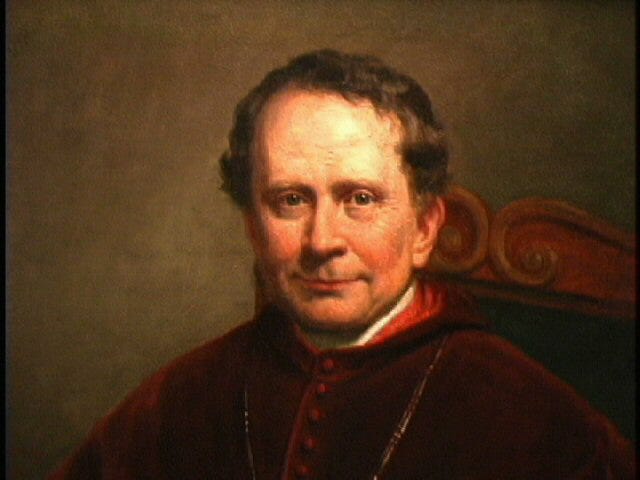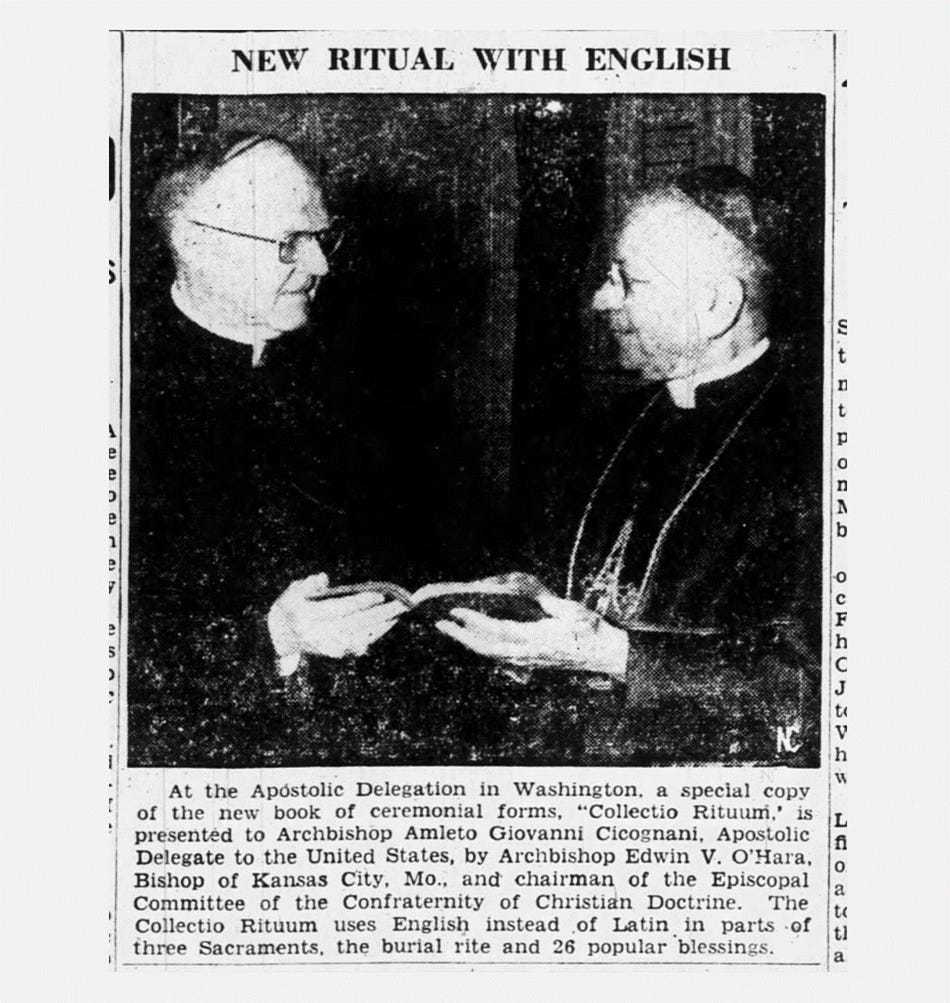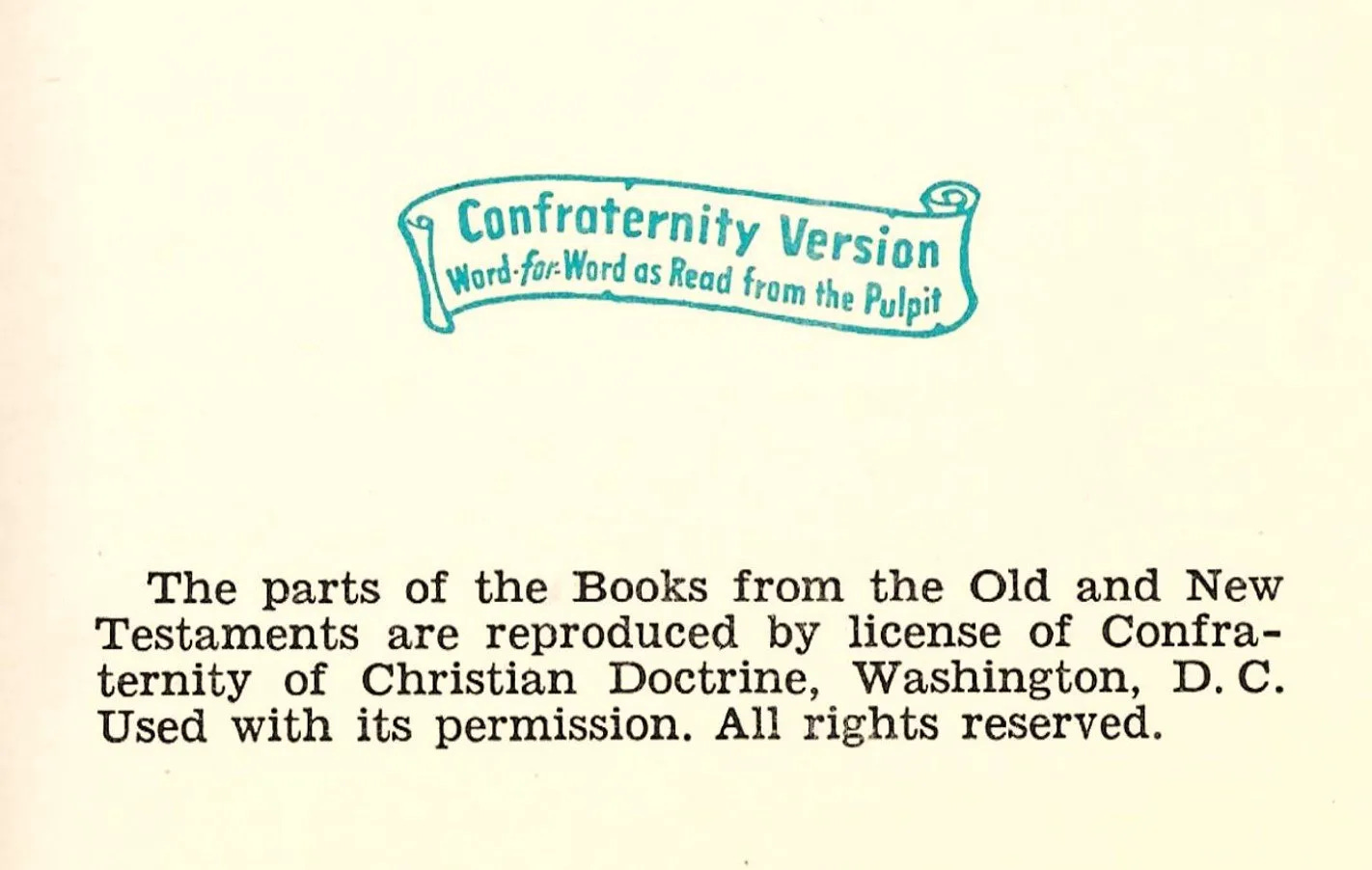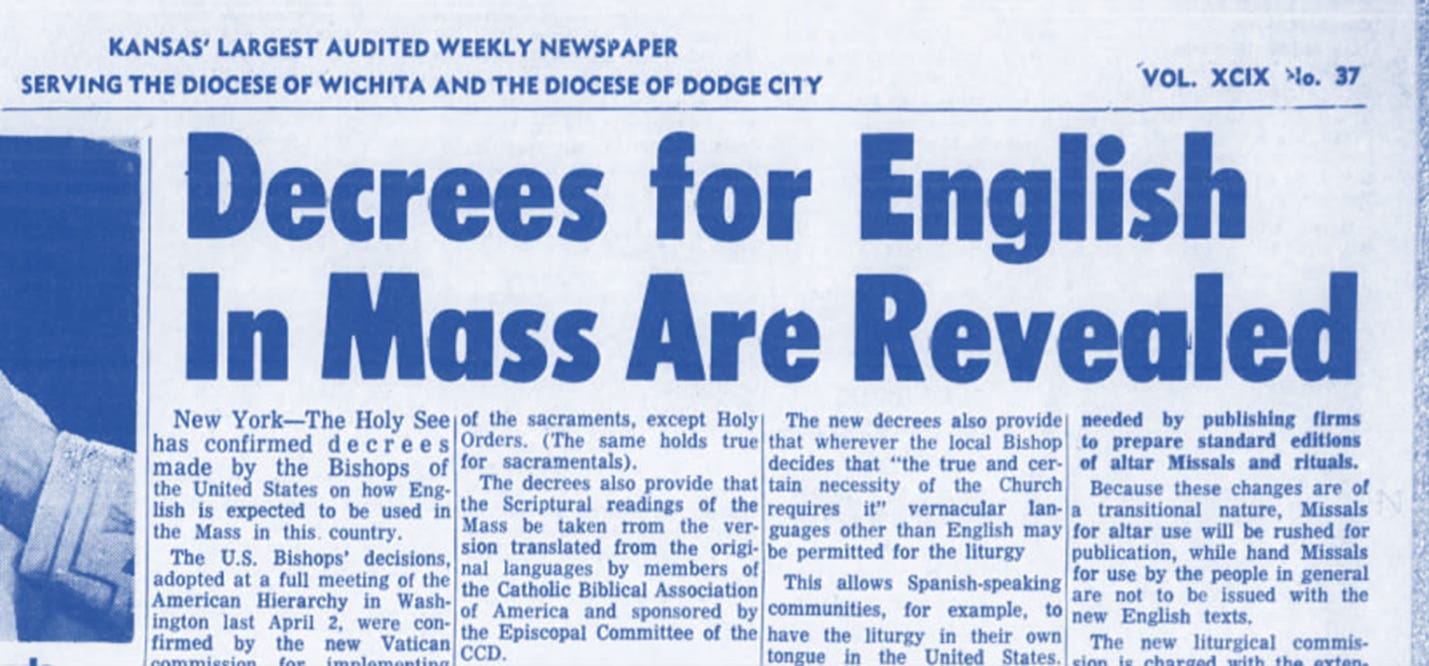The U.S. bishops’ conference made headlines last month, over a memo which reminded bishops that if parishes want to reprint scripture in bulletins or worship aids, they need to pay USCCB licensing fees for the privilege.

The U.S. bishops’ conference holds copyright to the English-language translation which is authorized for liturgical use in the U.S., and requires anyone – individuals, parishes, or publishing companies – to pay a license fee to reprint portions of the scripture readings.
But the licensing policy is controversial, and has been criticized by some Catholics – being described, for example, as “vulturous,” “shameful,” and “scandalous” by parish priests on twitter.com who wish to provide copies of the scriptures to their flock.
Mary Sperry, associate director for copyright and permissions at the USCCB, took pains to reiterate to The Pillar that “the money is not the point” of the license fee.
Annual financial statements indicate that all copyright royalties, of which scripture translations make up an unspecified part, generate between $2.2 and $2.4 million dollars annually, which is only 0.9% of the USCCB’s total operating revenue of $275 million dollars.
But despite assurances that financial considerations are secondary, the license fee structure - coupled with the USCCB’s swift legal responses to copyright violations - has led to pushback against the conference policy from some Catholics.
The current official English scripture translation for liturgical use in America is based on the New American Bible, originally published in 1970 with many subsequent revisions.
The official entity which holds the copyright to the translation is the Confraternity of Christian Doctrine, an entity legally incorporated in 1936, which is a subsidiary of the USCCB.
Sperry told The Pillar in January that there were previous versions of the scriptures published by the confraternity, and that the scripture text had only become copyrighted in response to other publishers making unauthorized changes to the text.
But what exactly is the Confraternity of Christian Doctrine, and what does it do – besides enforce scripture copyright?
How did the original confraternity version of the scriptures come to be, and how did they turn into the current New American Bible translation?
What is the history of copyrighted “official” scripture versions in America?
A - very - brief history of English bibles
It is a common misconception that most lay people during the Middle Ages did not and could not read the Bible in their own language.
That was because, the story goes, the Church only permitted the Bible to be printed in Latin and actively worked to prevent independent access to the scriptures to safeguard its power and control.
In popular accounts, it was only after the Protestant Reformations made the scriptures available in the vernacular that the Church was reluctantly forced to change.
But according to Frans van Liere, an expert in medieval history, there was actually a “flourishing culture of lay biblical literacy in the vernacular” in the Middle Ages, and a vast number of orthodox and approved vernacular translations of scripture which were used at home, at school, in the pew, and in the pulpit throughout Europe.
In England, there were many translations of the Pentateuch, the Psalms, the Gospels, and various other extracts and permutations of biblical material produced in Old and Middle English between ~700 and 1300 AD. There were also many editions of the Sunday scripture readings produced in English (and other languages) between ~970 and 1500 which were used for study and private reading by the laity and also recited from the pulpit during Mass.

By the late Middle Ages, these types of texts were quite popular in helping the laity encounter and engage with the scriptures.
There are multiple first-hand accounts attesting that many laypeople, even the poor and uneducated, were able to memorize a significant number of the biblical texts - centered on the liturgical scripture readings - in the vernacular.
In 1582, in the midst of what has been called the “golden age of Catholic biblical scholarship,” the first official post-Reformation Catholic translation of the New Testament in English was produced by the scholars of the English College located in Douai, France.
Published in Rheims, it became known as the Rheims New Testament version. The multi-volume Old Testament was published in 1609 and 1610 and was dubbed the Douay version of the Old Testament. This monumental work became collectively known as the Douay-Rheims Bible and remained the definitive Catholic edition of the scriptures in English for centuries afterwards.
In 1730, a young priest named Richard Challoner departed the English College in Douai to serve as a missionary priest in London. Catholicism was still illegal in England at this time, and Challoner threw himself into the urgent work of providing pastoral care to the small and neglected Catholic flock.
Challoner was a prolific writer and produced an astonishing list of catechetical, apologetic, devotional, and liturgical books which were deeply popular. Between 1748 and 1750, Challoner produced what would be one of his most significant and influential works: a new English translation of the Bible.

Although ostensibly a simple revision of the venerable Douay-Rheims version, the alterations were so substantial and numerous that it was almost wholly a new translation.
The Challoner revision would go on to become the normative English scripture translation for Catholic bibles and pulpit scripture books throughout the anglophone world and provide the groundwork for nearly all subsequent English translations until the 20th century.
The modern idea of ‘copyright’ did not exist during these years and certainly did not apply to Challoner’s translation. In the century following his translation, many publishers throughout the English-speaking world issued their own editions of Challoner’s version (with various minor edits or additions). While most claimed legal rights to their own specific editions, Challoner’s translation itself was not regulated or licensed.
Early American translations
In 1812, Irish-born Francis Kenrick was ordained a priest in Rome following his studies at the Pontifical Urbaniana University. That same year, he volunteered to be sent to the newly-created Diocese of Bardstown, Kentucky–a vast rural missionary territory with only a handful of priests. Kenrick taught theology at the Bardstown seminary and college, where he quickly earned a reputation as a scripture scholar.

In 1830, Kenrick was appointed coadjutor bishop of the Diocese of Philadelphia. In 1846, he began work on a revision to the Challoner version of the Bible, which he published in multiple volumes.
The revision would ultimately be completed in 1851, the same year Kenrick was appointed as Archbishop of Baltimore. His work was more than mere re-translation and included extensive commentary, offering textual, historical, theological, and interpretive notes.
Kenrick was one of the most prominent American prelates of the age, widely respected and influential. His version of the scriptures was moderately popular for a time. It was well reviewed by scholars on both sides of the Atlantic, though it was also the subject of some sharp criticism and did not receive the unanimous support of the American bishops.
Kenrick’s translation was copyrighted and was used for some ‘pulpit editions’ of the scripture readings, but never became a new ‘standard’ version of the English scriptures in America.
Bishop O’Hara and the Confraternity
In the early years of the 20th century, a growing number of voices argued that Catholics required a modern English translation of the scriptures better suited for modern needs. One American bishop in particular–Edwin V. O’Hara of Great Falls, Montana–was convinced of the need for a new Catholic version of scripture and of the need for an organized body of Catholic scripture scholars in the United States.
O’Hara was responsible for some of the most significant and transformative developments in the history of Catholicism in America. He was, among other things, responsible for the creation and success of the Catholic Rural Life program, the revision of the Baltimore Catechism, and the groundbreaking 1954 English-language Rituale.
In 1955, Vincent S. Waters, Bishop of Raleigh, said of O’Hara: “among the members of the hierarchy of the United States there is no one who has influenced the history of the church in this country more.”

O’Hara was also the driving force behind the establishment of a national Confraternity of Christian Doctrine, or CCD, in the United States.
The confraternity was a lay association dedicated to catechetical teaching and religious formation which developed out of the religious education system of Milan, Italy in the first few decades of the 16th century. In 1562, the confraternity was formally established in Rome by Pope Pius IV. It spread throughout Europe in the following centuries with constant support of the popes and many saints.
In 1905, Pope Pius X issued his encyclical Acerbo Nimis which, among other things, mandated that “in each and every parish the society, commonly called the Confraternity of Christian Doctrine, shall be canonically erected.” In the years which followed, the Confraternity was gradually introduced by dioceses throughout America.
O’Hara had been deeply interested in the confraternity since the pope’s encyclical. He had even preached one of his first sermons on the document following his ordination in June 1905. By the mid 1920s, O’Hara had become the strongest and most prominent champion of the confraternity within the American hierarchy.
In 1933, O’Hara achieved the establishment of a National Center for the Confraternity of Christian Doctrine in Washington, D.C.
A year later, O’Hara had convinced the American bishops to establish an episcopal committee for the CCD, of which he was elected chairman.
O’Hara would serve as the head of the committee until his death in 1956, overseeing the astonishing growth and success of a robust, professional, coordinated nationwide confraternity network and a transformation of religious education throughout the country.
The confraternity revision of 1941
In January 1936, Bishop Hara convened a meeting at The Catholic University of America of 15 prominent seminary scripture professors from around the nation.
The purpose of this meeting was to formulate goals and guiding principles for a modern revision of the Douay-Rheims New Testament which would be performed under the auspices of the U.S. Bishops and the CCD committee.
At a second meeting in April, the work of revision began in earnest, and Bishop O’Hara proposed the formation of a Catholic organization of scripture scholars to guide the revision and more generally promote Catholic scripture study. At the CCD’s national congress in October, a vote was taken to officially establish the Catholic Biblical Association of America, CBA, for that purpose.
In August 1940, Bishop O’Hara presided over the CBA’s annual general meeting in Toronto, and reviewed progress of the translation effort, which was on track for publication by spring 1941.
At this same meeting, O’Hara requested that the CBA also sponsor the publication of a separate book of Epistles and Gospels, using the new translation, for use by priests in the pulpit. After reciting the readings in Latin at the altar, the priest would use this book to proclaim the scriptures from the pulpit in English before preaching the sermon.
After nearly five years of work, the revised New Testament was completed in early 1941. It was published for the bishop’s committee by St. Anthony’s Guild Press of Patterson, New Jersey. The nationwide Holy Name Society, with local groups in almost every parish, undertook the work to distribute and promote the text, which was adopted nationwide on Pentecost Sunday.

That Sunday, May 18, 1941, was a landmark day in the history of the Catholic Church in the United States.
On that day, which had been designated as “Biblical Sunday” by O’Hara’s episcopal committee and the American bishops, more than 13 million Catholics in 72 dioceses heard the scripture readings of the Mass proclaimed from the pulpit, in English, from O’Hara’s new standard translation.
O’Hara’s goal was to promote the reading of the sacred scriptures and encourage adoption of the new Confraternity scripture translation of the New Testament. The slogan for the event was: “A New Testament in every home; the teaching of Christ in every heart.”
A highly coordinated publicity campaign promoted this innovative “Biblical Sunday”: Bishop O’Hara inaugurated the celebration at 11:45 a.m. with a national radio address.
A specially recorded program entitled “The Bible Through The Ages” was distributed to more than 13% of all radio stations in the nation.
Archbishop of Cincinnati John McNicholas, OP promoted the New Testament in a national television broadcast on NBC.
Special pastoral letters were read at Sunday Masses. Promotional posters were hung in churches. Themed events and programs were hosted at libraries, colleges, and high schools across the country. A copy of the Confraternity New Testament was even presented to President Franklin Delano Roosevelt at the White House.
The American bishops hoped that this new scripture translation would become the new standard edition for modern Catholics: it would be read at home, taught in schools, printed in hand missals, and heard every Sunday from the pulpit. All of this would help standardize and deepen the experience of the laity with the scriptures.
In the years that followed, additional portions of the bible were added to the Confraternity translation – Genesis was published in 1948, the Psalms in 1950, Exodus to Ruth in 1952, Isaiah to Malachi in 1961, and Samuel to Maccabees in 1969 – and that version of the scriptures became the normative edition for Catholics in the United States.
Confraternity Copyrights
This translation of the scriptures was copyrighted by the Confraternity of Christian Doctrine from the very beginning in 1941, following the standard practice in Catholic publishing of the era.
In the early 1940s, the use of hand missals and prayer books by the laity at Mass was extraordinarily widespread. The Sunday scripture readings were nearly always included in these prayer books, allowing the laity to pray and meditate upon the readings at home and in the pew.
Prior to 1941, the translations used for the scriptures varied, with some hand missals using custom translations and others using the venerable Challoner version of the Douay Rheims or other versions.

Once published by the U.S. Bishops, the new confraternity version of the scriptures was quickly adopted by Catholic publishers as a preferred ‘standard’ translation. They were included in multiple major hand missal and prayer book brands and in every major “pulpit edition” of the Sunday scripture readings, creating a fairly uniform liturgical experience throughout the United States. All of that was governed by licensing agreements with the confraternity.
However, the confraternity was willing to relinquish the copyright in response to pastoral necessity. In January 1942, as the United States mobilized for war, the army wanted to provide millions of copies of the scriptures to American soldiers.
Confessional-specific editions of the New and Old Testaments were issued for Catholics, Protestants, and Jews. For the “New Testament: Roman Catholic Version,” the army adopted Rev. Joseph Stedman’s “My Daily Reading from the New Testament,” which used the confraternity version of the scriptures.
The confraternity was praised in the press and received the thanks of army chaplaincy staff when it was made public that “the Confraternity of Christian Doctrine has released gratis its copyright to the revised New Testament, to permit its being used as the basis of ‘Daily Readings from the New Testament,’ now being printed for the Catholic men in the United States Army.”
The confraternity version of 1964
After the promulgation of the liturgical constitution of the Second Vatican Council in December 1963 and the subsequent instructions of Paul VI in January 1964, the bishops of the United States met in Washington D.C. to develop proposals and timelines for implementing liturgical changes in the United States.
On April 2, 1964, the hierarchy of the United States issued decrees which outlined various norms and directives for liturgy based on the texts of the Second Vatican Council.
In these decrees, the American bishops selected the confraternity translation of the scriptures as the authorized version for use in the coming revised liturgy.
Interestingly, the National Conference of Catholic Bishops in the United States was not the only episcopal conference to authorize the confraternity version of scriptures for liturgical use following Vatican II.
In fact, the Canadian bishops were the first to do so, approving the confraternity version for English liturgical use in Canada in February 1964, and the bishops of Vietnam did likewise in April.

For reasons that are not clear, it was decided to produce a revised scripture translation for the 1964 liturgical changes instead of continuing to use the very popular version which had been used throughout the nation since 1941.
The American bishops, aiming for flexibility in that liturgically turbulent year, authorized for liturgical use both the 1941 confraternity translation and any potential future revisions to the confraternity version.
The result was somewhat of a liturgical mismash. Some American dioceses, such as Boston and Winona, adopted the existing confraternity translation, at least immediately, while many others waited to use the very rushed revised translations which debuted in November 1964.
Unlike the overwhelming success of the original confraternity scriptures which debuted on “Biblical Sunday” in 1941, the revised 1964 translation was widely panned and was the subject of a great deal of public criticism from both clerics and laity alike.
Here’s how one layman, a former Protestant, described his feelings in an April 1965 letter to the editor in the Lake Shore Visitor, the newspaper of the Diocese of Erie:
“The new translation of the Gospels and epistles is frightful. The language is banal and often stupid. It lacks majesty and clarity and it degrades the great thinkers of the early church to the level of third grade teachers.”
The revised 1964 translations were widely viewed as suffering from what could be described as linguistic infelicities which contributed to the discontent surrounding them.
Some randomly-selected examples from the new translations may help illustrate how the laity heard the Sunday scriptures in English beginning in November 1964:
Mark 16:5-6 – On entering the tomb, they saw a young man sitting at the right, dressed in a white robe. This thoroughly amazed them. But he reassured them, “No need to be amazed! You are looking for Jesus of Nazareth, the crucified. He has been raised: he is not here.”
Matthew 8:8,13 – “Lord,” replied the centurion, “I am not worthy to have you enter my house. Just give an order, and my boy will get better.” [...] To the centurion Jesus said, “Go home. It shall be done in answer to your faith.” The boy got better that very moment.”
The Twilight of the confraternity
The original pre-1964 translation of the confraternity continued to be sold in the years which followed, remaining the standard scripture text used by the American Catholic laity, while the revised 1964 translation remained in use in the ‘interim’ liturgies which followed the Second Vatican Council.
That fact continued to produce frustration and a striking contrast between the American hierarchy’s standard translation which the laity read at home and the American hierarchy’s standard translation which was heard during the liturgy.
Like so many other former fixtures of American Catholic life, the confraternity soon fell victim to the whirlwind of changes and reforms of these years. In 1969, the Bishops’ Committee on the Confraternity of Christian Doctrine was dissolved; just five years later, the National Center of the Confraternity of Christian Doctrine was also dissolved.
Then came a series of nearly constant translation updates, revisions, and controversy which only further erased the memory and former stability of the Confraternity scriptures.
In 1970, the Catholic Biblical Association of America issued the New American Bible, a work which adapted the confraternity translations by extending the 1964 revisions throughout the New Testament and also updated the Old Testament books.
Just a few years later, a new, new translation effort was begun and the New American Bible With Revised New Testament was published in 1986.
The American bishops then used the 1986 NAB to create a new Lectionary for Mass which was published in 1992. The Vatican refused to approve this translation for five years due to concerns with the translation, so the bishops again revised the Lectionary for Mass in 1997 and approval for Volume I (for Sundays) was approved in 1998.
The U.S. bishops also approved a new version of the psalms for use at Mass in 1995. A year later, that translation was judged doctrinally defective and forbidden for liturgical use by the Congregation for the Doctrine of the Faith.
In 2001, Vatican approval was finally granted to Volume II, for Weekdays, of the new lectionary originally submitted by the U.S. bishops in 1992 and revised in 1997.
In 2012, the U.S. bishops announced yet another translation project for a new edition of the New American Bible, after which another revised version of the Lectionary for Mass will be published – likely in 2026 or later. All of those translations have been copyrighted, licensed, and highly regulated by the USCCB.
–
Despite its active history in the early part of the 20th century, the Confraternity of Christian Doctrine in America has been essentially dead for decades, existing mostly today as a legal entity for the purposes of holding and enforcing copyright.
But while the confraternity scriptures were copyrighted and regulated by the American bishops beginning in 1941, the impact of holding and licensing these scripture copyrights is substantially different in the modern situation.
Before the Second Vatican Council, the financial burden of confraternity licensing fees never fell to individuals or parishes. That was because the Catholic world was awash with prayer books and devotional aids which contained the scriptures, already-licensed, the Mass texts, catechetical materials, devotions, and more.
Within the framework of the revised liturgy and approach to participation, however, that is no longer the case. The current approach to copyright, fees, and enforcement of these essential texts has raised criticism from Catholics who say it hampers, rather than helps, the devotional, catechetical and evangelical mission of the Church in America.
Meanwhile, unlike the decades and centuries preceding the Second Vatican Council, the modern Catholic laity’s experience of vernacular scripture has been anything but stable or uniform.
Given that history, it is unclear whether the USCCB copyright office will continue with the practices of its past, or it will eventually heed calls to rethink the bishops’s approach to maintaining rights over the approved versions of English scriptures and other essential texts of liturgical worship and Catholic life.
No comments:
Post a Comment